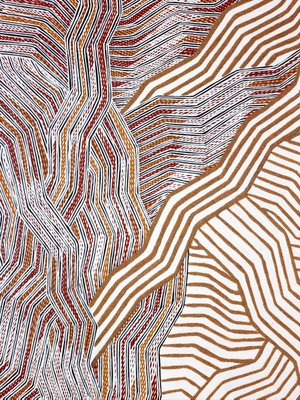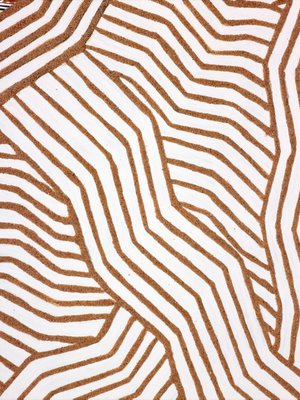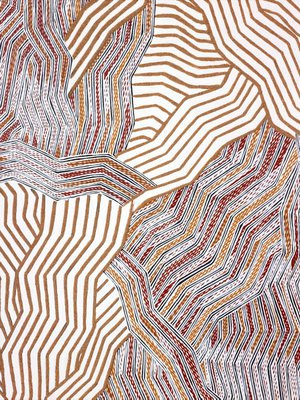Title
Garraparra
2015
Artist



-
Details
- Place where the work was made
-
Gangan
→
North-east Arnhem Land
→
Northern Territory
→
Australia
- Cultural origin
- Dhalwangu/Arnhem region
- Date
- 2015
- Media category
- Painting
- Materials used
- natural pigments on board
- Dimensions
- 121.0 x 56.0 cm
- Signature & date
Not signed. Not dated.
- Credit
- Purchased with funds provided by the Aboriginal Art Collection Benefactors 2015
- Location
- Not on display
- Accession number
- 246.2015
- Copyright
- © the artist courtesy Buku-Larrnggay Mulka Art Centre
- Artist information
-
Lamangirra Gumana
Works in the collection
- Share
-
-
About
Lamaŋirra Gumana lives and works in Gangan, a remote homeland in the Blue Mud Bay region of north-east Arnhem Land. She has long assisted her husband, Gunybi Ganambarr, with his work. However she recently began working under her own name and is emerging as an innovative artist experimenting within the inherited designs of the Dhalwangu clan.
'Garraparra' 2015 depicts a coastal headland and bay area within Blue Mud Bay, and more specifially the Yirritja saltwater of the area called Muŋurru. The wavy lines and overlapping fields of line-work represent the multidirectional waters of Djalma Bay created by the south-easterly gusts of the early dry season.
The art centre documentation for this work states:
Garraparra is a coastal headland and bay area within Blue Mud Bay. It marks the spot of a sacred burial area for the Dhalwaŋu clan and a site where dispute was formally settled by Makarrata (a trial of ordeal by spear which settled serious grievance and sealed the peace forever).During the times after the ‘first mornings’ ancestral hunters left the shores of Garraparra in their canoe towards the horizon hunting for turtle. Sacred songs and dance narrate the heroic adventures of these two men as they passed sacred areas, rocks and saw ancestral totems on their way. Their hunting came to grief, with the canoe capsising and the hunters being drowned. The bodies washed back to the shores of Garraparra with the currents and the tides, as the Waŋupini followed with its rain and wind. Their canoe with paddle and Makani (queen fish), Minyga (long tom)
and Gårun (turtle) are all referred to in the songs and landscape. Makarrata, the ritual throwing of spears at a miscreant of Yolŋu law took place here. At Garraparra sacred trees held these barbed spears whilst not in use.Garraparra has been rendered by the wavy design for Yirritja saltwater in Blue Mud Bay called Muŋurru. The Muŋurru is deep water that has many states and connects with the sacred waters coming from the land estates by currents and tidal action. Other clans of Blue Mud Bay that share similar mythology of the Yiŋapunjapu, i.e. the Madarrpa and Maŋgalili also paint the deeper saltwater - the Muŋurru as such. This sacred design shows the water of Djalma Bay chopped up by the blustery south easterlies of the early dry season.
From freshwater the waters migrate to Muŋurru the mighty undifferentiated Yirritja saltwater ocean that plays at the horizon which receives and unifies all the Yirritja coastal saltwaters in one. It is from here that the water (soul) transmogrifies to vapour to enter the 'pregnant' Waŋupini (Wet Season storm clouds) which carry the life giving freshwater back to the start of the cycle.
